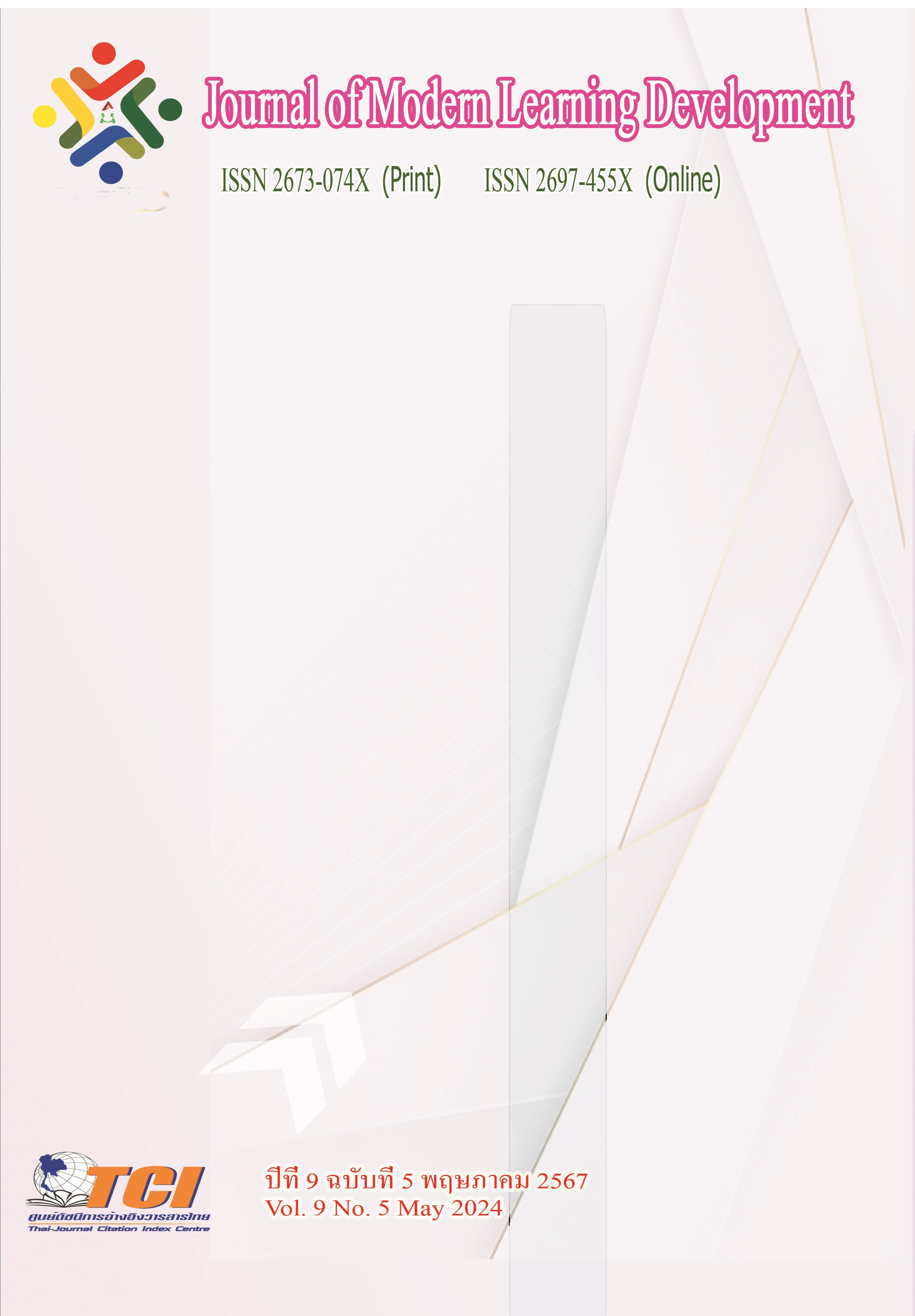Guidelines for the Development of Operations of Basketry Community Enterprises, Muang District, Phitsanulok Province
Main Article Content
Abstract
The objectives of this research were 1) to study the operating conditions of basketry community enterprises, Muang District, Phitsanulok Province, 2) to study problems and obstacles to the operation of basketry community enterprises, 3) to study the guidelines for the development of operations of basketry community enterprises. The samples were divided into 3 groups: 1) Government agencies, Local leaders, 2) academics, and 3) members of community enterprises, basketry group. The data were collected by interview, data from documentation, and analyzed; described all data. The results revealed that:
1. The operating conditions: 1.1 Group production will be produced to orders to meet the needs of buyers; 1.2 The marketing and pricing are set by the producers who are elderly so it affected the price setting; 1.3 Management is handled in the form of a meeting committee to solve problems; 1.4 Group finances do not place an emphasis on bookkeeping; 1.5 Participation in decision-making receives benefits including solving problems in groups; 1.6 Leadership has a good group management plan and the annual dividend is allocated; 1.7 There is no labor cost in recruiting labor from other localities; 1.8 Membership management has set membership conditions; 1.9 External interactions provide training to organize the group; 1.10 Meeting news information is conducted for development work.
2. Problems and obstacles: 2.1 The production has labor costs resulting in a high selling price; 2.2 Marketing and sales do not have many distribution channels, distributed according to government events; 2.3 Management within the group is not a problem; 2.4 Finance is insufficient for operations; 2.5 Lack of participation in the formulation of plans and policies; 2.6 Leadership lacks understanding of consumer needs; 2.7 Workers lack knowledge on how to organize without hiring workers outside the group; 2.8 Member management has an insufficient budget for welfare allocation; 2.9 Interaction with the outside, there is no network of additional occupation groups with other communities; 2.10 Regarding the lack of information exchange with successful community enterprise groups.
3. Development guidelines: Government agencies promote the development of labor skills to meet the standards. Products are intermediaries between community enterprises and consumers. Increase marketing opportunities and improve rules and regulations to suit and apply to all members.
Article Details
References
กิตติคุณ แสงนิล และสันติธร ภูริภักดี. (2561). การศึกษาแนวทางการบริหารจัดการ เพื่อความยั่งยืนด้วยหลักปรัชญาของเศรษฐกิจพอเพียงของวิสาหกิจเพื่อสังคม กรณีศึกษา สามพรานโมเดล. วารสาร Veridian E-Journal, Silpakorn University. 11 (1), 168-182.
ชนนิกานต์ อินทรเผือก, ประเพศ ไกรจันทร์ และทวีศักดิ์ รูปสิงห์. (2564). รูปแบบการจัดการวิสาหกิจชุมชนเพื่อการเติบโตอย่างยั่งยืน. วารสารครุศาสตร์อุตสาหกรรม พระจอมเกล้าพระนครเหนือ. 12 (2), 46-56.
ชนพงษ์ อาภรณ์พิศาล. (2560). ปัจจัยที่มีอิทธิพลต่อประสิทธิผลการบริหารจัดการวิสาหกิจชุมชนในภาคกลางของประเทศไทย. ดุษฎีนิพนธ์ปริญญาปรัชญาดุษฎีบัณฑิต (สาขาวิชาการจัดการ). บัณฑิตวิทยาลัย: มหาวิทยาลัยสยาม.
ชมพูนุท จั่นปุ๋ย. (2562). การถอดบทเรียนความสําเร็จของวิสาหกิจชุมชนบนพื้นฐานความอยู่รอดและพอเพียง. วิทยานิพนธ์ศิลปศาสตรมหาบัณฑิต (สาขาวิชาพัฒนา มนุษย์และสังคม (สหสาขาวิชา). บัณฑิตวิทยาลัย: จุฬาลงกรณ์มหาวิทยาลัย.
ณัชชา ณัฐโชติภคิน, อนุวัติ กระสังข์ และเกียรติศักดิ์ สุขเหลือง. (2562). กระบวนการสร้างเครือข่ายวิสาหกิจชุมชนตําบลไร่ขิง อําเภอสามพราน จังหวัดนครปฐม. วารสารศิลปะศาสตร์ ราชมงคลสุวรรณภูมิ. 1 (1), 31 – 40.
ดวงเดือน สมวัฒนศักดิ์. (2548). วิสาหกิจชุมชน. ชัยนาท : สํานักงานส่งเสริมและพัฒนาการเกษตร เขตที่ 1 จังหวัดชัยนาท กรมส่งเสริมการเกษตร.
พระครูวิโชติสิกขกิจ, ศราวุธ ปลอดภัย และ ปริญญา นิกรกุล. (2564). การพัฒนาทรัพยากรมนุษย์กลุ่มวิสาหกิจชุมชนในจังหวัดพิจิตรตามแนวพระพุทธศาสนา. วารสารวิจัยวิชาการ. 4 (1), 1-12.
ไพพรรณ เกียรติโชติชัย. (2551). กิจกรรมการศึกษาเพื่อการพัฒนาท้องถิ่น. กรุงเทพมหานคร: ศรีอนันต์การพิมพ์.
วรรณพงค์ ช่วยรักษา. (2560). แนวทางการพัฒนาวิสาหกิจชุมชน: กรณีศึกษา กลุ่มสตรีทอผ้าฝ้ายย้อมคราม บ้านถ้ำเต่า จังหวัดสกลนคร. วิทยาลัยพาณิชยศาสตร์มหาวิทยาลัยบูรพา.
วิทยา จันทะวงศ์ศรี. (2557). ปัจจัยที่มีผลต่อความสำเร็จของกลุ่มวิสาหกิจชุมชน อำเภอกันทรวิชัย จังหวัดมหาสารคาม. วิทยานิพนธ์ปริญญาเศรษฐศาสตร์มหาบัณฑิตสาขาวิชาเศรษฐศาสตร์ธุรกิจ. บัณฑิตวิทยาลัย: มหาวิทยาลัยขอนแก่น.
วิมลสิริ ถูกขุนทดและคณะ. (2563). การพัฒนาวิสาหกิจชุมชนสู่ความสำเร็จ : กรณีศึกษาวิสาหกิจชุมชนกลุ่มผู้ผลิตและพัฒนาการแปรรูปกล้วยตำบลระหาน อำเภอบึงสามัคคี จังหวัดกำแพงเพชร. การประชุมวิชาการการพัฒนาชุมชน ท้องถิ่นและสังคมระดับชาติ (CSD สัมพันธ์). 19, 671-678.
ศักดิ์ดา ศิริภัทรโสภณ. (2558). การศึกษากรอบแนวคิดเพื่อการพัฒนาวิสาหกิจชุมชนเพื่อสังคมในประเทศไทย. วารสารสมาคมนักวิจัย. 20 (2), 30-47.
สมชาย น้อยฉ่ำ และคณะ. (2561, มีนาคม), การบริหารจัดการวิสาหกิจชุมชน อําเภออัมพวาจังหวัดสมุทรสงคราม. วารสารเกษมบัณฑิต. 19 (ฉบับพิเศษ), 1 - 10.
เอื้องฟ้า เขากลม, มนทิรา สังข์ทอง และ เมธาวัตร ภูธรภักดี และคณะ. (2565). แนวทางการพัฒนาศักยภาพห่วงโซ่คุณค่าของวิสาหกิจชุมชนผักกูดบ้านเสมา จังหวัดนครศรีธรรมราช. วารสารมหาจุฬานาครทรรศน์. 9 (2), 1 - 15.


